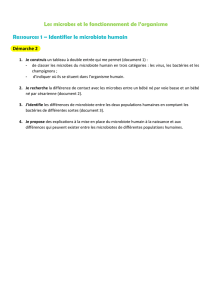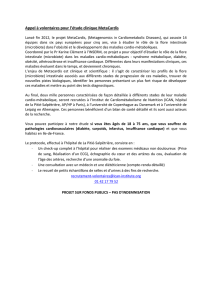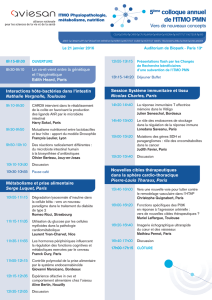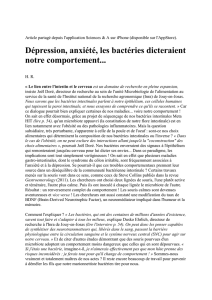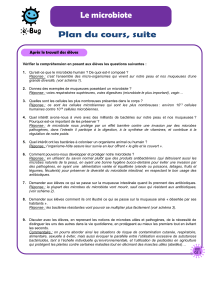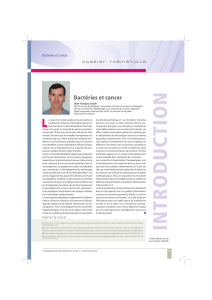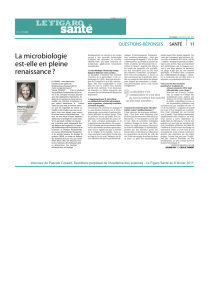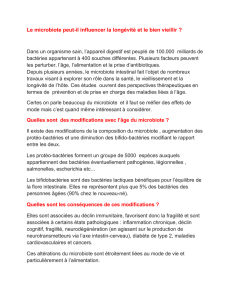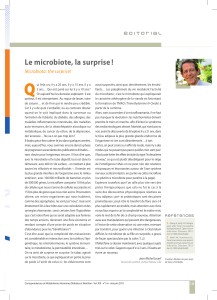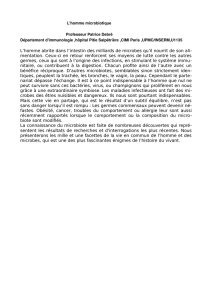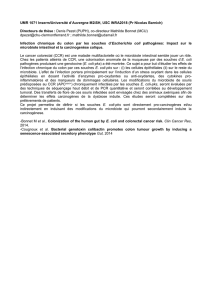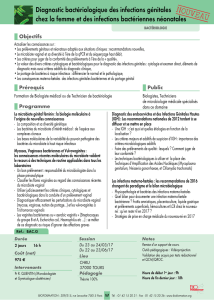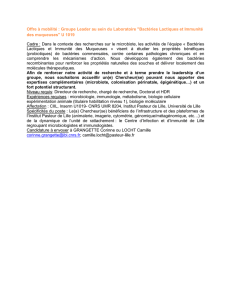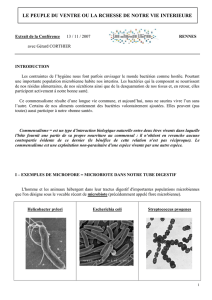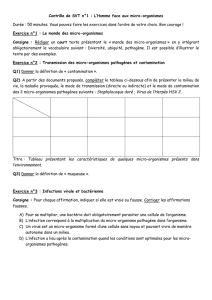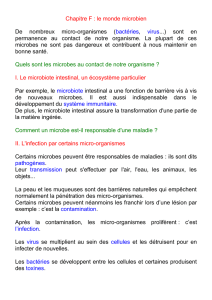le microbiote (sfb)
publicité
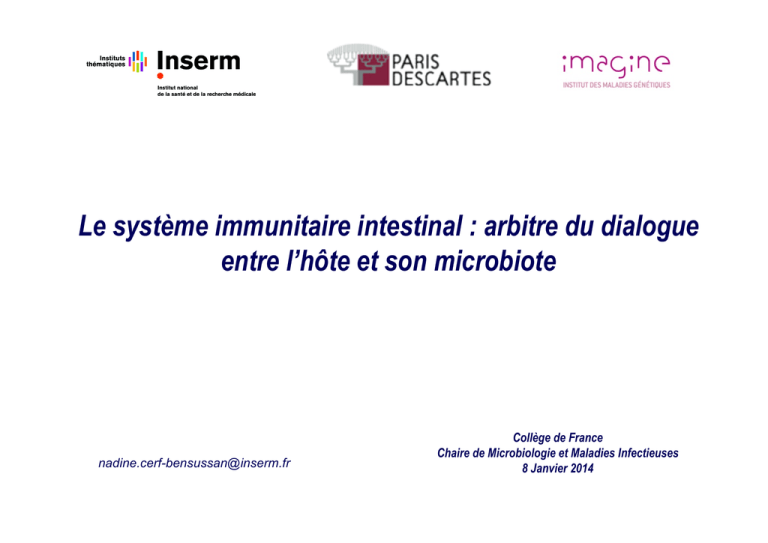
Le système immunitaire intestinal : arbitre du dialogue entre l’hôte et son microbiote [email protected] Collège de France Chaire de Microbiologie et Maladies Infectieuses 8 Janvier 2014 C.R. Woese 1928-2012 16SRNA: tool for phylogeny of prokaryotes Woese, C. R.; G. E. Fox (1977) "Phylogenetic structure of the prokaryotic domain: The primary kingdoms". Proceedings of the National Academy of Sciences 74 (11): 5088–5090. « The Microbial World—Biology’s Sleeping Giant » « The cellular biomass on this planet is predominantly microbial (24), and in numbers the earth’s microbial population completely dwarfs that of multicellular organisms. It is the web of interactions among microorganisms that defines and supports the biosphere, the global ecosystem. » L’HOMME ET SES COMMUNAUTES MICROBIENNES Ileum/ Iléon/colon 1014 bactéries Dethlefsen et al Nature 2007 QUEL COMPROMIS EVOLUTIF A PERMIS ET MAINTIENT DES INTERACTIONS MUTUALISTES ENTRE L’HOTE ET SON MICROBIOTE Intestin distal 1014 symbionts >1000 espèces 7 (2) phyla 3 millions gènes Avantages métaboliques INNE ARBITRE: SYSTEME IMMUNITAIRE DE L’HOTE ADAPTATIF SYSTEME IMMUNITAIRE ET MICROBIOTE BARRIERE REGULATION POUR CIRCONSCRIRE LE MICROBIOTE DANS LA LUMIÈRE INTESTINALE POUR LIMITER L’INFLAMMATION DELETERE POUR CHAQUE PARTENAIRE DEFENSES INNEES MUCUS Bactéries EPITHELIUM Johansson et al PNAS 2008 Barrière physique et chimique régulée par les signaux microbiens via des récepteurs Toll et NOD/NLR PEPTIDES MICROBICIDES REG3γ WT MYD88-/- Bactéries Vaishnava et al Science 2011 DEFENSES INNEES EPITHELIUM Barrière Recrutement de cellules immunitaires mobiles chimiokines Phagocytes Macrophages/polynucléaires COLITE DESTRUCTIVE LORS D’UNE INFECTION PAR SHIGELLE Lumière Infiltration massive du colon par des polynucléaires Coût>bénéfice? IMMUNITE INNEE : REGULATION Récepteurs motifs microbiens< TLR Nod1/2 NALP/ IPAF NF-kB RECRUTEMENT/ACTIVATION PHAGOCYTES Activation cascades intracellulaires CYTOKINES ET CHIMIOKINES DEFENSINES IMMUNITE INNEE : REGULATION Récepteurs motifs microbiens< TLR Nod1/2 NALP/ IPAF NF-kB RECRUTEMENT/ACTIVATION PHAGOCYTES Activation cascades intracellulaires CYTOKINES ET CHIMIOKINES DEFENSINES Immunité adaptative Immunité innée Rapide mais peu spécifique et sans mémoire Spécificité, mémoire, régulation Phagocytes Epithélium 1010? lymphocytes T et B /m intestin Macrophages Polynucléaires Cellules dendritiques Cellules lymphoïdes innées IMMUNITE ADAPTATIVE ET INTESTIN Cellules M LT EFFECTEURS PLASMOCYTES IgA Dôme Zone T PLAQUES DE PEYER SITES INDUCTEURS Activation des lymphocytes T et B naifs GANGLIONS MESENTERIQUES Zone B SITE EFFECTEUR OUTIL: SOURIS AXENIQUES ET GNOTOXENIQUES nées et élevées en conditions stériles colonisées par des bactéries/flores sélectionnées Seminars in Immunology 19 (2007) 59–69 Seminars in Immunology 19 (2007) 59–69 Review Review UseUse of of axenic studying the adaptation of mammals axenic animals animals in in studying the adaptation of mammals their commensal intestinal microbiota toto their commensal intestinal microbiota Karen Smith, Kathy D. McCoy _, Andre_w J. Macpherson Karen Department Smith,of Medicine Kathy D. McCoy , Andre w J. Macpherson , McMaster Univer sity, Hamilton, Ontario, Canada Seminars in Immunology Department of Medicine , McMaster Univer sity, Hamilton, Ontario, Canada Abstract Abstract 19 (2007) 59–69 Review Use of axenic animals in studying the adaptation of Vertebrates are essentially born germ-free but normally acquire a comple x intestinal microbiota soon after birth. Most of these organisms are non- Dévelopment de la barrière immune intestinale GC Maturation dépendante du microbiote T défensines PP IgA Plaques de Peyer Follicules Gg mésentériques lymphoides cryptoplaques Programme génétique Période anténatale J0 J8 (souris) Période post natale La colonisation de souris par une flore murine induit un large éventail de réponses immunes qui s’équilibrent et maintiennent l’homéostasie intestinale Barrière innée Barrière adaptative Peptides anti-microbiens TH1, TH2, TH17 Treg (IL10, Foxp3) SIgA Gaboriau-Routhiau et al Immunity 2009 LA COMPOSITION DU MICROBIOTE PEUT-ELLER INFLUER SUR LA MATURATION DES RÉPONSES IMMUNITAIRES ADAPTATIVES ? Bactéries ? Régulation Inflammation UNE FLORE HUMAINE N’INDUIT QUE TRES FAIBLEMENT LES GENES TEMOINS D’UNE RÉPONSE IMMMUNE DANS L’INTESTIN MURIN Immune response Metabolism Response to extracellular stimulus Cell cycle Transcription Signal transduction Chemotaxis Cell adhesion Transport G-protein signaling Neurophysiological process Apoptosis and survival Translation Cytoskeleton remodeling Cell process Transcriptome iléal comparé à celui de souris axéniques Cv Cvd Hum 60 d Souris colonisées à l’âge adulte par la flore des souris J8, J20, J60 Immune response Metabolism Souris colonisées à l’âge adulte par une flore humaine J8, J20, J60 Response to extracellular stimulus Cell cycle Cytoskeleton remodeling Cell adhesion Transcription G-protein signaling Transport Signal transduction Gaboriau-Routhiau et al Immunity 2009 Chemotaxis Chang et al Cell 2012 Apoptosis and survival Translation Muscle contraction Oxidative stress 0 5 10 15 20 25 30 35 40 45 50 Souris conventionelles colonisées à la naissance LA MAJORITE DES BACTERIES DU MICROBIOTE INDUISENT LA PRODUCTION DE SIgA ET DE FAÇON VARIABLE UNE REPONSE T REGULATRICE MICROBIOTE MURIN COMPLET IgA mRNA « innés » TH1, TH2, TH17, Treg (IL10, Fopx3) Espèces cultivables en monocolonisation Fraction CULTIVABLE du microbiote murin Microbiote HUMAIN complet Gaboriau-Routhiau et al Immunity 2009, Nature Rev Immunol 2010, Lochner et al JI 2011 Lecuyer et al Cur op Gastroenterology 2011, Eberl& Cerf-Bensussan Seminar in Immunology 2012 “PEACE-KEEPING TRADE-OFF” DES BACTERIES INTESTINALES COLONISANT LE MUCUS Induction de SIgA favorisant l’exclusion des bactéries dans la lumière intestinale et leur accrochage dans le mucus Induction de LT régulateurs évitant une réponse inflammatoire excessive délétère pour les bactéries et leurs hôtes Treg TFH IgA Mazmanian et al Science 2008;Science 2010 Sokol et al PNAS 2008, Cong et al PNAS 2009 Geuking et al Immunity 2011 Atarashi et al Science 2011, Nature 2013 Treg may also promote IgA responses Tsuji et al Science 2009; Cong et al PNAS 2009 QUELLE(S) ESPECES SONT NECESSAIRES A LA MATURATION COMPLETE DE LA BARRIERE IMMUNE INTESTINALE (LT EFFECTEURS) CHEZ LA SOURIS? MICROBIOTE MURIN COMPLET IgA mRNA « innés » TH1, TH2, TH17, Treg (IL10, Fopx3) Espèces cultivables en monocolonisation Fraction CULTIVABLE du microbiote murin Microbiote HUMAIN complet Fraction chauffée du microbiote murin enrichis en clostridiums non cultivables formant des spores Gaboriau-Routhiau et al Immunity 2009, Nature Rev Immunol 2010, Lochner et al JI 2011 Lecuyer et al Cur op Gastroenterology 2011, Eberl& Cerf-Bensussan Seminar in Immunology 2012 SEGMENTED FILAMENTOUS BACTERIUM (SFB) UN BON CANDIDAT ? - Espèce apparentée aux Clostridiums et formant des spores décrite pour sa morphologie inhabituelle en 1849 (Leidy? Candidatus arthromitus?) ou 1960 (Savage) - Détectée (16SRNA) chez de nombreuses espèces vertébrés (poissons , oiseaux, mammifères) (Snel et al. 1995) - mais avec une spécificité d’hôte nécessaire à son adhérence à l’iléon des rongeurs (Davis & Savage 1974, Tannock et al. 1984, Okada et al. 1994) - s’installant dans l’iléon au sevrage lors du début de la maturation du système immunitaire intestinal adaptatif - Non-cultivable mais purifiée par passage chez des souris axéniques et disponible en monocolonisation (Klaasen et al. 1991, Umesaki 1995) - capable d’induire en monocolonisation une très forte réponse IgA et le recrutement de LT CD8+ activés dans l’épithélium intestinal (Klaasen et al. 1993, Talham et al. 1999, Umesaki et al. 1995) SFB EST UN PUISSANT INDUCTEUR DE LA MATURATION POSTNATALE DE LA BARRIERE IMMUNE INTESTINALE MICROBIOTE MURIN COMPLET SFB Réponses immunes innées (ileum) Cytokines proinflammatoires /chimiokines Réponses immunes adaptatives CD4+ LPL (TH1,2,17, Treg) barrière microbicide RegIIIγ, MMP7 Gaboriau-Routhiau et al Immunity 2009, Nature Rev Immunol 2010,Ivanov et al Cell 2009, Lochner et al JI 2011 Lecuyer et al Cur op Gastroenterology 2011, Schnupf et al Seminar in Immunology 2013 SIgA CD8 IEL Talham et al. 1999 Umesaki et al. 1995 DIFFERENTS COMPROMIS SONT POSSIBLES ENTRE BACTERIES SYMBIOTIQUES ET HOTES IMMUNOCOMPETENTS Bactéries vivant dans le mucus Bactéries vivant en contact plus intime avec leur hôte SFB réponse innées IgA Treg TFH IgA Treg T inflam « rôle privilégié dans l’induction de la barrière immune intestinale ? » Reviewed in Schnupf et al Sem Immunol 2013 QUESTION 1 : QUEL(S) MECHANISM(S) EXPLIQUE(NT) LES PROPRIETES FORTEMENT IMMUNOSTIMULANTES DE SFB ? H1= ADHERENCE AUX PLAQUES DE PEYER? SFB H2= ADHERENCE à un récepteur capable d’induire un fort signal inné nécessaire à une forte réponse adapta8ve effectrice (TH17) LTβRIg TLR? TLR Induc8on de 8ssu lymphoïde organisé réponses IgA/IL-­‐17 NF-kB ? QUESTIONS (2) - Existe-t-il une version de SFB propre à l’homme ? Yin Y et al : Comparative analysis of the distribution of segmented filamentous bacteria in humans, mice and chickens. ISME J 2012. -Est-elle aussi capable d’orchester la maturation de la barrière immune intestinale - D’autres bactéries du microbiote peuvent elles induire une réponse inflammatoire capable de stimuler la maturation physiologique de la barrière immune intestinale ? QUESTION 3: COUTS ET BENEFICES DE LA COLONISATION PAR SFB POUR L’HOTE Effets locaux Hôte immunocompétent Hôte avec défaut de régulation immunitaire Inflammation contrôlée renforçant la barrière épithéliale Inflammation pathologique en synergie avec d’autres bactéries Stepankova et al IBD 2007 Effets à distance Préactivation/effet adjuvant des défenses anti-infectieuses? Protection contre le diabète de type I de la souris NOD Kriegel et al PNAS 2011 Aggravation EAE : Lee et al YK et al PNAS 2010 Arthrites autoimmunes: Wu HJ et al Immunity 2010 Chappert et al Immunity 2013 LE MICROBIOTE (SFB) CALIBRE LE SEUIL D’ACTIVATION DES REPONSES IMMUNES SYSTEMIQUES INNEES ET ADAPTATIVES « EFFET ADJUVANT » An Immunomodulatory Molecule of Symbiotic Bacteria Directs Maturation of the Host Immune System Sarkis K. Mazmanian,1,3,* Cui Hua Liu,1,2 Arthur O. Tzianabos,1,3 and Dennis L. Kasper1,3,* D. Artis &coll A. Diefenbach &coll Cell 2005 UN SYSTEME IMMUNITAIRE COMPETENT EST CLE POUR GERER LES INTERACTIONS HOTE-MICROBIOTE BACTERIES du MICROBIOTE INTESTINAL Sepsis sévère en cas de déficit immunitaire B. fragilis Inflammation en cas d’immunorégulation altérée Modèles murins Maladies inflammatoires intestinales humaines MODELES MURINS DE COLITES INFLAMMATION DEPENDANTE DU MICROBIOTE Altérations de la barrière épithéliale - Destruction chimique (DSS) - Inactivation molécules contrôlant l’étanchéité (E-cadhérine) - Défaut de régulation négative des « Toll like » recepteurs - Défaut de production de défensines et/ou de mucus * mutations de NOD * mutations des signaux d’autophagie (ATG16L1) * mutations des voies du stress du réticulum endoplasmique Altérations des mécanismes immunorégulateurs KO: IL2/IL2Rα β, IL10, RIL10, TGFβ Lack of FOXP3 SEVERE COLITE À DEBUT PRECOCE CHEZ LES ENFANTS AVEC UN DEFAUT DE SIGNALISATION DE L’INTERLEUKINE 10 Glocker et al NEJM 2009 Begue et al AJG 2011 production de cytokines proinflammatoires par des monocytes sanguins stimulés par le LPS % Pas d’ inhibition par l’ IL-10 Patient 3 stop codon exon 3 rIL10b Patient 11 mutation ponctuelle rIL10a CD n=35 UC n=27 EO-IBD n=11 Pat.3 Pat.11 Healthy Controls n=20 qRT-PCR colonic biopsies FACTEURS DE PREDISPOSITION GENETIQUE AUX MALADIES INFLAMMATOIRES INTESTINALES Cho & Brant Gastroenterology 2011 ENVIRONMENT Début précoce Début tardif « Genome wide associations » :163 polymorphismes génétiques défensines Rendant compte de seulement 14% du risque de développer une maladie inflammatoire intestinale mucus QUELS FACTEURS ENVIRONNEMENTAUX ALTERENT LE DIALOGUE ENTRE L’HOTE ET SON MICROBIOTE ET EXPLIQUENT L’AUGMENTATION RECENTE CONSIDERABLE DES MICI Effets opposés pour Crohn et RCH MICROBIOTE INFLAMMATION PHYSIOLOGIQUE HOTE Barrière épithéliale Système immunitaire INFLAMMATION PATHOLOGIQUE Inflammation dysbiose Déséquilibre de la composition du microbiote avec Perte de bactéries aux effets immunorégulateurs Sokol et al PNAS 2008 A decrease of the butyrate-prducing species Roseburia hominis and Faecalibacterium prausnitzii defines dysbiosis in patients with ulcerative colitis Machiels K et al. Gut 2013 Emergence de bactéries plus agressives (protéobactéries) Emergence d’E. coli adhérents-invasifs (LF82) dans l’iléon de M . Crohn Darfeuille-Michaud et coll Bacteroidetes Firmicutes Enterobacteriacae 0.1% microbiote Inflammation intestinale Induction NO synthase (cellules épithéliales) Nitrate (NO3-) Nitrate respiration Nitrate reductases Nitrite (NO2-) Avantage compétitif = mutants unable to reduce nitrate CONCLUSION: HOTE ET MICROBIOTE ENTRETIENNENT UN DIALOGUE DYNAMIQUE À TRAVERS LE SYSTEME IMMUNITAIRE SFB, autres? Effet barrière Cerf-Bensussan & Gaboriau-Routhiau Nat Rev Immunol 2010 TRAITEMENTS? INSERM U989 and INRA MICALIS Paris Valérie Gaboriau-Routhiau Emelyne Lecuyer Hélène Lengliné Sabine Rakotobe Jouy-en-Josas Hervé Blottière Tomas de Wouters Catherine Juste Joël Doré Emmanuelle Maguin ANAXEM platform Rowett Institute, Aberdeen Denise Kelly INSERM U781, Paris Claude-Agnès Reynaud Institut Pasteur, Paris Gerard Eberl Philippe Sansonetti Pamela Schnupf University of Bern Andrew Macpherson Kathy McCoy Jeff Browning Biogenidec Giovanni Brandi University of Bologna Hans Snel Nizo Food Research
